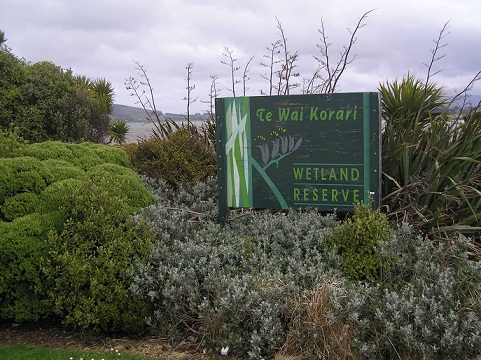Te Wai Korari – The Wetland That Made it Through
Every time I drive past Te Wai Korari wetland on the edge of our little south coast town, I thank my lucky star. Given that I pass by quite often,
that’s a lot of thanking! The wetland and it’s winding waterways and ponds could quite easily have become what most of Southland has morphed into over the past century – pasture for sheep and cows to chew down and pug up but some good timing and good luck meant that we were able to buy the parcel of undeveloped harakeke ‘swamp’ from the farmer, just days before the ploughs moved in.
Those were exciting times, wandering through the wiwi beds, amongst the harakeke and mikimiki, exploring our new playground and planning ways to protect it further; from rabbits, gorse, the wave action from the estuary – all sorts of threats to the essentially untouched state it was in.
We fenced it, reshaped the straight-as-a-ruler drains the farmer had gouged out in order to drain his farm further up the slope, formed a pond that we hoped would attract inanga from the expanses of the brackish estuary and planted ti kouka on the slopes above the wetland, all good restoration type of activities and great things for school groups, teams of prisoners, gangs and the volunteers of our estuary care group to take part in.
Then came the issue of finding a name for the wetland reserve. We thought, ‘Good Wetland’, after the farmer Maurice Good, who had subdivided and sold the land to us, but the thought occurred to me that the area might already carry a pre-European name. I wrote to the local runaka – Oraka/Aparima and asked if they knew and if we might use the original name for the site and waited for their reply. And waited. Patiently. Expectantly.
After several months and a hui that involved discussion on the issue, a beautifully handwritten letter arrived from te tari runaka. Yes, they said, the area was named long ago and yes, they would like to gift us the use of that name. Te Wai Korari. The nectar of the harakeke flower, named from the practice of collecting wai korari from the flowers to be drunk as a ‘cordial’ by children and adults alike, back in the day when sugar was truly a treat, not a mainstay like it is today. So Te Wai Korari it is.
Our panel marking the entrance to the wetland is painted with nga rau harakeke me nga korari, puawai hoki, flax leaves, flower stalks and
blossoms and the beautiful name. There was more too, in the letter from our generous ropu tangata whenua. Each small bay around the edge of the estuary has a name that describes its nature – the ease with which whitebait can be scooped up with a kete, the liking kingfishers have for
the clay banks in one bay, the kohanga provided to calf dolphins in another. Both poetic and descriptive, those names from nga wa o mua add a
lovely dimension to our work and serve as a tie that binds us to the whenua and her kiatiaki tuturu..
About the Author
Robert lives as far away from the hurly burly as possible, in the small fishing village of Riverton on the south coast of the South Island. He’s
tucked himself and his charming family into a snug two-storeyed cottage in the middle of an orchard-garden where he taps out messages of hope for anyone who will listen.
He’s worked for and with local iwi on many projects, including visits to offshore islands where titi are still harvested by Rakiura Maori, and
while there managed to keep his head down long enough to pass for someone useful. As Kaiwhakaako Maori at Aparima college, Robert has taken the chance to share his hands-on experience as a pakeha involved with mahi nga kai and other mahi tuturu of nga tangata whenua of the deep south with any students not completely entranced by their ipod.
loading...
loading...


I’ve unashamedly given myself an up-tick so that I’m encouraged to write some more.
Murihiku has stories that will, I believe, be meaningful to anyone with a skerrick of interest in cordial relations between races and I have to say, it’s fun writing about them.
Rob
loading...
loading...
top article Rob!
loading...
loading...
Thanks Nick!
GSX – etc…you are a spam.
loading...
loading...
hi.
Im trying to find the name of the harakeke flower but can only find reference to the stalk – korari. After reading the above article Im wondering is the flower part called the korari too?
loading...
loading...
Hi SB – so far as I know, the generic word puawai is used to describe the harakeke flower (te puawai o te harakeke) as in the blossom of the flax. There are probably many site-specific words that have been used but I don’t know them.
Robert
loading...
loading...